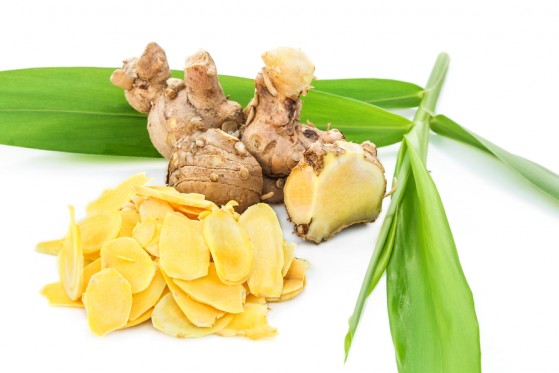Spices Of Life: Health Benefits Of Ginger.
“If it came from a plant, eat it. If it was made in a plant, don’t.” ~ Michael Pollan
History of Ginger
Ginger: Zingiberaceae; Zingiber officinale; Asarum canadence
Also known as: Gengibre, Gingembre, Sheng Jian, Singabera, Zanjibel, Jengibre, Ajenjibre, Jenijibre,
Originally found in Southeast Asia, ginger is now grown in most tropical regions of the world. A perennial, it can grow several feet high, producing fragrant white or yellow flowers. The portion of the ginger plant that is most useful is the rhizome, or the root, which grows horizontally under the ground, branching off and making offshoots at will. The ginger root is thick, fragrant, woody and tuberous, and can be harvested once the plant is about nine or ten months mature.
Ginger has been used as a culinary and medicinal herb for thousands of years. Some medieval Europeans believed it originated within the biblical Garden of Eden, and its revered nature within ancient religious traditions is further revealed with Allah proclaiming that it awaits the righteous in heaven.
“And they will be given there a cup mixed with Zanjabil.” (Qur’an 76:17)
Ginger is also referenced by Confucius, who noted its hot qualities and recommended its dietary inclusion.
“Eat ginger but in moderation so as not to increase the internal heat of the body.” ~ Confucius
Ayurvedic medicine has long incorporated ginger into diet and healing, especially noted for aiding in digestion and specifically noted for daily use with those of the Vata body type. Chinese medicine notes its use in dispelling winds in the body.
Healing Properties of Ginger Root
Ginger is said to possess several healing and medicinal properties, and has been found by researchers to be effective for use in a variety of ailments.
Some of the most common indications, both historically and in modern investigation, include:
- Antiemetic
- Anti-nausea
- Antiseptic
- Anti-inflammatory
- Detoxification
- Postpartum care
- Antibacterial
- Antiviral
- Antifungal
- Antitussive
- Analgesic
- Anticoagulant
- Circulatory agent
- Expectorant
- Hypotensive
- Peripheral vasodilation
Use is cautioned if you are already predisposed to hot or overactive digestion, if you have active ulcers, or if you are pregnant.
Ginger has been found to prevent motion sickness, lower blood cholesterol, stimulate respiratory function, thin blood, reduce inflammation, raise low blood pressure and may help to prevent cancer. Additional actions of ginger may include helping to return the uterus to normal size after childbirth, treat rheumatism, relieve post-operative and chemotherapy-related nausea, and increase bile production to aid in digestion. Ginger is also believed to have topical analgesic properties when applied directly to the skin.
The use of ginger in treating infectious and inflammatory illnesses, such as colds, flu, food poisoning and malaria, has been widely noted, and ginger root may be active against infectious agents such as E. coli, Staphylococcus, Streptococcus, Salmonella, Pseudomonas and Candida.
How to Use Ginger
The most active properties of ginger are found in the root, or rhizome, and in essential oil derived from the plant. Use of the essential oil in beauty products such as lotions and tinctures is common, with some products touted as effective at both reducing inflammation and helping the body to burn fat.
Ginger is most commonly used directly in food and beverage consumption. Ginger teas, beers and ales have been found for centuries, enhancing the beneficial digestive properties of the herb and presenting easy methods for ingestion. Modern day ginger ales rarely contain any actual ginger, but you can make your own if you are so inclined. A simple infusion of ginger in water, carbonated water or even white wine can be made easily and quickly, allowing even the busiest of people to take advantage of the healing properties of ginger.
Mildly processed and preserved ginger products, such as chutneys, pickled ginger and dried or candied ginger, are readily available in most supermarkets as is the spice version, which is simply dried and ground ginger. You can also find or include ginger in more heavily processed foods including baked goods (think gingerbread), soups and stews, and recipes ranging from stir-fry to desserts.
The ginger rhizome is available in markets year round, and is most often sold in its root form. Bulk ginger commonly has the dried skin still attached, which may be easily peeled off with a knife or vegetable peeler. Once you have peeled the ginger, you can slice, shred, grate or dice the root. Minced or shredded ginger tends to be more pungent than sliced ginger, allowing you to choose the level of heat you want to result when you use it in recipes. Ginger can be eaten raw or used in cooking, which can slightly decrease the fiery nature of the root.
If you’re using fresh ginger in your kitchen for the first time, you may want to start with a small addition, as some people find it to be quite powerful — adding a significant amount of heat to food. This is due to the presence of the acrid component, gingerol, which is responsible for most of the stimulating properties and the hot flavor.
If you are already a diehard ginger-lover, you already know just how wonderful it is to masticate on a slice of this gingerol-rich root while you prepare the rest for use.
I have used ginger for years, and consider it a staple in my kitchen, making sure I have a good-sized piece of ginger root on hand at all times. I add it to smoothies and juices, and use it in cooking both savory and sweet dishes. You can keep ginger fresh in the refrigerator for up to a month, or unrefrigerated for a couple of weeks, especially if you obtain ginger root that is firm and blemish-free.
Though I’ve incorporated ginger into my diet for decades, I recently began taking ginger therapeutically on a daily basis. I use a simple infusion of ginger water to aid in digestion and improve overall health, incorporating the beneficial properties of this spice into my normal routine. I noticed a decrease in inflammatory processes and an improvement in digestion within the first days, and get to enjoy ginger’s distinct flavor each day, which I’ve noticed to bring a profoundly simple benefit — it makes me smile more.
“If man has no tea in him, he is incapable of understanding truth and beauty.” ~ Japanese Proverb
Simple Alchemy: Ginger Tisane
Here is a quick and easy ginger tea recipe, intended to promote wellness and bring a dose of internal sunshine to your day.
To prepare your ginger tisane, you will need:
- Fresh ginger root
- Filtered water
Wash and peel a pinky-sized piece of ginger root, or as much as you like, according to your tastes. Slice, mince or grate the fresh ginger, noting that the more surface area you start with, the spicier and bolder your tea will be.
Bring a quart of water to a boil, then pour over ginger in a heat resistant container. I use a quart mason jar when using this method. Cover and let steep at least ten minutes.
You can also add the prepared ginger directly to your teapot or pan of water, bring it to a boil, then remove from heat, cover and let steep. This may give you a bolder flavor in less time, but I find that I can detect a slight metallic taste if I add the ginger directly to my teapot.
Once you have let the ginger steep as long as you like, you can strain it out or enjoy your tea exactly as it is. I usually prepare my ginger tisane before bedtime and let the infusion steep overnight, to ensure it is as bold as a direct ray of sunlight by morning. As a result, I have an ample supply of ginger tea that I can start my morning with, then continue to enjoy well into the day.
This recipe is delicious warm and fresh, as well as poured over ice midday. If you prefer, you may add any of the following optional ingredients while steeping, individually or in combination, to create richer flavor and add additional health benefits.
Optional Ingredients:
- Natural honey
- Freshly squeezed lemon or lime
- Agave nectar
- Turmeric root or powder
- Chamomile flowers
- Clove
- Star anise
- Cinnamon stick
Feel free to play around, and be sure to leave your own recipes below, for all of us to share!
“A recipe has no soul. You, as the cook, must bring soul to the recipe.” ~ Thomas Keller
*As with any medicinal herb, ginger root should be used in moderation and only with special consideration if you are pregnant or nursing, if you have significant health issues or if you experience any side effects with use.
***
{Join us on Facebook, Twitter & Instagram}



